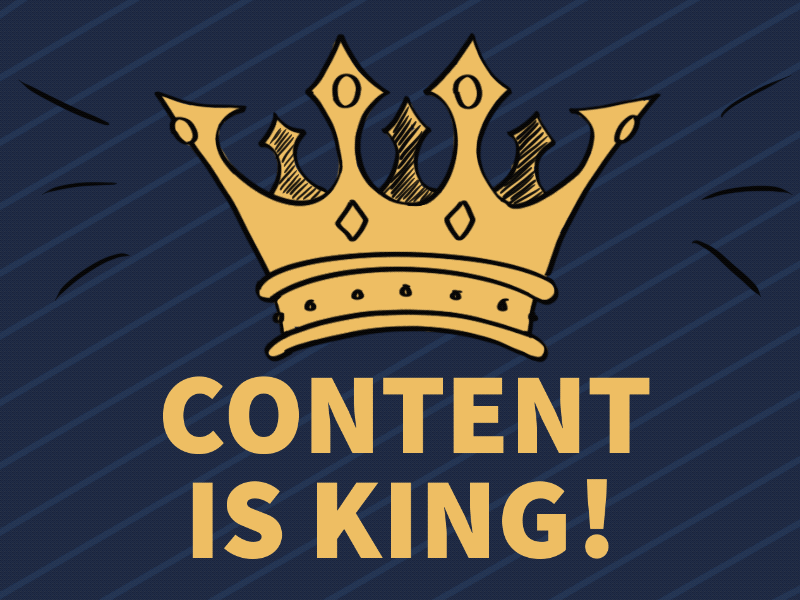
Did you know that the quote “Content is king” comes from Bill Gates? Back in 1996, he foresaw that the digital future would be all about content. Since then, it’s been an often-heard marketing phrase, but what’s it actually all about? Why is content so important? Before we can answer this question, we should first clarify what exactly content can mean.
If you are a content newbie and enter the term into Google, you will quickly find what you are looking for in a (web) encyclopedia that we are all familiar with. There, content is defined as follows:
[…] Content (media), information or experience provided to audience or end-users by publishers or media producers
Content industry, an umbrella term that encompasses companies owning and providing mass media and media metadata
[…]
Web content, information published on the World Wide Web
The latter point is the common form of content when it comes to online marketing. People often think of online content first, as the term only came into being in the wake of the latest technical developments on the Internet. It simply needed a term that could better describe what texts, images, animations, links, etc. make up in their entirety. The Anglicism has also established itself in other languages.
But does content based on the first definition mean nothing other than multimedia content? In principle, that is correct. This means that a newspaper article can also be content, since it refers to a mass medium and usually combines text and images. In other words, it uses different media forms.
“But then content is old hat!“, you may be thinking now.
The concept of content marketing actually is. Some even claim that Benjamin Franklin invented the whole thing by publishing the annual Poor Richard’s Almanack in 1732, which he used to advertise his printing business by mixing informative and entertaining texts.
But especially for the digital fields in marketing, high-quality content is very important. After all, what company can still do without an online presence? In order for this to be found, the content must be SEO. As a result, search engines rank the website highly, which in turn increases the chance that (potential) customers will find the company’s own products and services.
Storytelling is the keyword. Someone who tells stories around a product, taking into account the wishes and needs of the target group, achieves more than someone who simply describes the product. Don’t you think? Just think back to 2014 and the movie The LEGO Movie. Here, even feature-length content marketing was done in the form of storytelling. It was so successful that a second part hit the theaters.

“It may be easy to tell stories for toys, but for my products and services?” you may be thinking. The key to success is to ask what moves customers and provide solutions with “valuable” content.
Not only do we need to reach the target audience for this, but we also need to make sure they stay tuned. And that requires “added value”. Want an example?
I notice pests on one of my indoor plants and I am searching the internet for a solution. On the website of a well-known pesticide manufacturer, I find the category “Remedy for pests”, can use this page to identify the pests and in addition find tips on how to combat them. I also see that the manufacturer has linked profiles on social networks and decide to follow the brand there to be continuously informed about practical tips.
Still not convinced? Perhaps the topic of hard drive backup is a bit more difficult to leverage content strategies. However, in 2005, the manufacturer LiveVault managed to win over many new customers with a video that went viral. The video actually told just one story: Monty Python star John Cleese is the head of the “Institute for Backup Trauma (IBT)” and humorously illustrates the advantages of hard disk backup as opposed to tape.
Although content marketing is an old concept – what’s new are the many opportunities it offers, especially in the online world. So, content is indeed king, if it is valuable content with a clever strategy that keeps different target groups and media in mind. And why the Anglicism fits best becomes clear when you become aware of the additional meaning of the word. “Content” comes from Latin “contentus” and also means “satisfied” (for comparison: Ital. (essere) contento or fran. (être) content). And that is ultimately the most important thing in content marketing: content that satisfies everyone. For this reason, we have summarized the most important tips for your content strategy:
This all sounds interesting, but what exactly does it have to do with the PAC advertising agency? In the last couple of years, we positioned ourselves even more broadly in the areas of content and social media and formed larger teams. This will allow us to continue to proactively develop concepts for our clients’ target groups in the future that envision content marketing as a permanent building block in corporate communications.
We look forward to producing valuable content with moving stories for our existing and new customers. For example, a video we realized for the original SIMSON spare parts manufacturer MZA shows what this can look like.
Did you like this article? Then don’t miss our next one. Click here to subscribe to our newsletter.